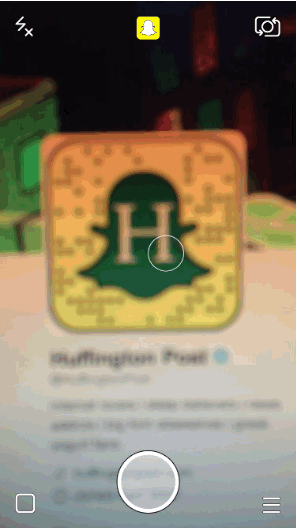Save 50% on a 3-month Digiday+ membership. Ends Dec 12.

For the handful of publishers that get top billing on Snapchat Discover, attracting new viewers has been pretty straightforward. Everyone else has had to work a bit harder.
Over the last few weeks a handful of publishers, including The Huffington Post, Mic and Distractify have experimented with replacing their Twitter and Facebook avatars with custom Snapchat QR codes. Web surfers can photograph the QR codes with their Snapchat apps, which signs them up as a follower of the publisher’s Snapchat Story.
“The friction here is pretty low,” said Distractify vp content strategy Jake Beckman. “Snapchat users who see the code are already primed to think of Snapchat when they see it, and there’s a pretty low barrier to entry with it versus opening the app and searching for us directly.”
Publishers say the tactic is a response to the challenge of getting people to not only find them on Snapchat but know they’re on Snapchat in the first place. “Snapchat being a closed platform with no real network effects, we needed an effective way to get people to follow us, so doing something like this felt like a good way to do that,” said Ethan Klapper, the Huffington Post’s global social media editor.
The tactic seems to be paying off. Mic, which swapped out its Twitter avatar in late August, said that the tactic helped quadruple its daily new-follower count, though it did not even give specific numbers. The number was even more significant when Mic used the same tactic on Facebook, where it saw 15 times as many new daily followers. Distractify and The Huffington Post have also seen increases in follower counts by using this tactic.
 What’s not clear is how much overlap there is between the people who follow publishers on Twitter and those who follow them on Snapchat. Twitter’s largest demographic is 25- to 34-year-olds, while 45 percent of Snapchat’s users are 18 to 24, according to data from BI Intelligence. Still, publishers are committed to using their presences on established platforms to boost their numbers on Snapchat, which offers a unique way to tell stories and the chance to reach new readers.
What’s not clear is how much overlap there is between the people who follow publishers on Twitter and those who follow them on Snapchat. Twitter’s largest demographic is 25- to 34-year-olds, while 45 percent of Snapchat’s users are 18 to 24, according to data from BI Intelligence. Still, publishers are committed to using their presences on established platforms to boost their numbers on Snapchat, which offers a unique way to tell stories and the chance to reach new readers.
Snapchat itself hasn’t made doing so easy for them. Snapchat quietly introduced its customizable “Boo-R” codes in January to make it easier for its users to share their Snapchat identities outside the app, particularly on other platforms. Reaching outside its platform has been essential, as Snapchat still doesn’t offer an easy way to look up users within the app itself. One third-party effort at solving the problem is SnapCodes, which creates and shares curated lists of Snapchat creators across categories such as news, sports and brands.
“There’s a huge discovery issue on Snapchat,” said Nick Cicero, CEO Delmondo, which connects Snapchat influencers with brands. “People don’t just want to consume what Snapchat serves them; they want to find new and interesting people to follow.”
More in Media

Digiday+ Research: Publishers’ growing focus on video doesn’t translate to social platforms
Major publishers have made recent investments in vertical video, but that shift is not carrying over to social media platforms.

Technology x humanity: A conversation with Dayforce’s Amy Capellanti-Wolf
Capellanti-Wolf shared insight on everything from navigating AI adoption and combating burnout to rethinking talent strategies.

How The Arena Group is rewriting its commercial playbook for the zero-click era
The company is testing AI-powered content recommendation models to keep readers moving through its network of sites and, in doing so, bump up revenue per session – its core performance metric.





